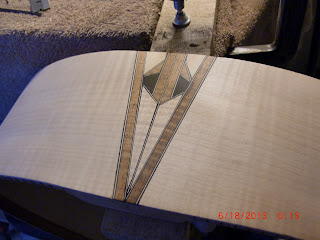 |
| Carbon Fiber Supports |
Carbon fiber is a wonderful material, and over the years I have come to love working with it in all of my builds. It has a structure similar to wood in many ways, and carries sound like wood does yet is stronger and lighter than wood. There really is no down side to using carbon fiber in key places that need the added stiffness and support without adding any real weight.
In the picture above I have begun to add the carbon fiber to the bridge plate and the upper bout. When I am finished there will be carbon strips in all the key points along the sides of the guitar protecting both the upper and lower bouts and adding stiffness to the entire instrument which enhances to sustain. I get all of my carbon fiber products from dragon plate, a high modulus military grade supplier of carbon fiber products. I will also use some braided carbon fiber rods to support the neck block, I have found that doing this helps keep the action of the guitar true in diverse climate conditions.
You can see that the soundboard and sides have been mated together finally, I assemble all my guitars and ukuleles in the classical style, soundboard first. There is in my mind no better way to fine tune the soundboard than to do it with the sides attached. The majority of tuning is done before assembly but with the back off I can fine tune the soundboard to the sides much easier allowing for a better relationship between those components most closely related to one another. I make my backs stiff, but slightly responsive as well. They however do not need to be tuned as the soundboard does and I can easily adjust the sound of the back by thinning it slightly after attaching it.
The scale length, stiffness of the top and the size of strings used as well as the expected style of playing are all taken into consideration when tuning a guitar top. There are many great luthiers who have delved into this in great detail I would suggest reading Ervin Somogyi the responsive guitar, it will begin your journey into that crazy world of soundboard dynamics but if you are like me and can never stop learning, it is only the tip of the iceberg.
Needless to say I have come a long ways in my journey of lutherie and I will forever be learning, because I know we should never grow to old to learn.
 |
| Tail Graft Inlay |
I thought I would show you how the tail graft inlay was coming along. Staying with the Colonial theme I wanted to add a Native American aspect to the guitar, hence the arrow head motif. Using the Curly KOA, Flamed Maple, Ebony and BWB wood purfling strips as well as some Spruce the design emulates some Native American art that I have studied.
Sometimes I work from a predesigned idea, but with the Colonial guitar I am moving as I am inspired, following where my heart and soul take me, believing in the beauty of the theme and the art. It is a very exhilarating experience to say the least.
I am excited to announce that we will be starting another blog along side this one very soon! A customer from New Zealand has commissioned a themed concert ukulele that will be designed around the Maori culture. I will be trying to keep track of both builds as they unfold. Stay tuned exciting things to come! Check out the build here
http://maoriconcertukulele.blogspot.com/2013/06/the-maori-themed-concert-ukulele.html
Don't forget to visit our website www.vallisguitars.com
for information on custom guitars please contact sales@vallisguitars.com

























